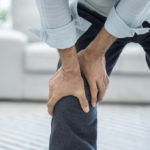The knee is the largest “hinge” joint in the body. It’s also one of the most important joints for mobility and weight-bearing activities.
The role of the knee is obvious in activities like walking, running, standing up, sitting down, and climbing stairs. Knees are also used for many other activities when the role isn’t so obvious. For instance, it’s your knees that help you lift and carry heavy loads. They also help you stay balanced and stable while you’re just standing still.
Like your other joints, you probably don’t give a lot of thought to your knees — until they start causing problems. Knee pain and related symptoms, like stiffness and reduced range of motion, are among the most common joint-related complaints. And while some minor pain issues, like overuse of your knees, might be treated with a little rest, in most cases, serious knee pain needs prompt medical attention.
What causes knee pain?

Your knees may look or even “act” like a basic hinge, but the structure of the joint is amazingly complex. The knee joint forms where your upper leg bone (your femur) and lower leg bones (the tibia and fibula) meet. Your kneecap (patella) is the fourth bone that makes up the knee joint. All these bones are connected by fibrous bands called ligaments. You’ve probably heard of at least one of these ligaments — the anterior cruciate ligament, or ACL – since it tends to feature prominently in a lot of well-publicized sports injuries. The other three primary ligaments in the knee are the posterior cruciate ligament (PCL), the medial collateral ligament (MCL) and the lateral collateral ligament (LCL).
In addition to these major joint components, your knee joint depends on tendons, muscles, and a couple of cushions called menisci to help you move freely and without pain. A covering of thick, slick cartilage protects the ends of the bones from wear and tear while also reducing friction inside the joint, helping your knee bend and flex without “sticking.” Damage to any of these structures can wind up causing pain and problems with the way your knee “works.”
So how can you tell if your knee pain is serious?
When most people think of serious knee pain, they think of pain that occurs suddenly, after a fall or other accident. And it’s true — sudden knee pain is often associated with serious injuries, including fractures and torn ligaments. But the fact is, no type of knee pain is “normal.”
Chronic knee pain that develops slowly over time tends to be ignored or even accepted as part of getting older. The problem with that approach is that chronic, slowly-developing pain is an indication that something’s wrong with your knee. That means you need to take some sort of action to correct the underlying problem. Doing so can restore normal, pain-free function, and prevent serious problems from developing.
Should you seek medical attention for your knee pain?
Whether you’re experiencing chronic or sudden knee pain, it’s important to see a doctor as soon as possible so you can start treatment — and start feeling better. The only time it might be OK to take a wait-and-see approach is if you’re having very minor, mild pain with no other symptoms following a period of strenuous activity.
For instance, if you just finished a marathon or you’ve been lifting a lot of heavy objects over a short period of time. In those instances, your mild pain might be caused by temporary muscle strain, and it might be OK to apply ice, elevate your leg and rest it as much as possible. If the painful symptoms persist or get worse, you should absolutely call the office and make an appointment.
When should you go to the ER for knee pain?
The next question is, if you have serious knee pain, how quickly should you seek treatment? Do you need to head to the emergency room? Can you wait until after the weekend to schedule an office visit? And the answer to those questions depends largely on an evaluation of your other symptoms. Knee pain does not require an ER visit, but you should see a doctor immediately. Especially, if your knee pain is accompanied by any of these symptoms:
- Reduced range of motion or loss of function in the joint
- A “popping” noise or sensation in the joint at the time of injury
- Problems walking or bearing weight on the knee
- Instability in the joint or the sensation your knee will “give way”
- Joint deformity (the joint appears misshapen, especially when compared with the other knee)
- Redness or swelling around the joint
In any event, it’s a good idea to call our office to discuss your symptoms and determine the best way to treat them. The bottom line: No type of knee pain is normal, and no pain should be ignored. Calling our office takes a few minutes of your time, but it could wind up helping you avoid weeks, months and even years of worsening symptoms.
Dr. Van Thiel treats patients from all over Wisconsin and Illinois including Rockford, Elgin, Huntley, Dekalb, Crystal Lake, Barrington, McHenry, and Beloit.




